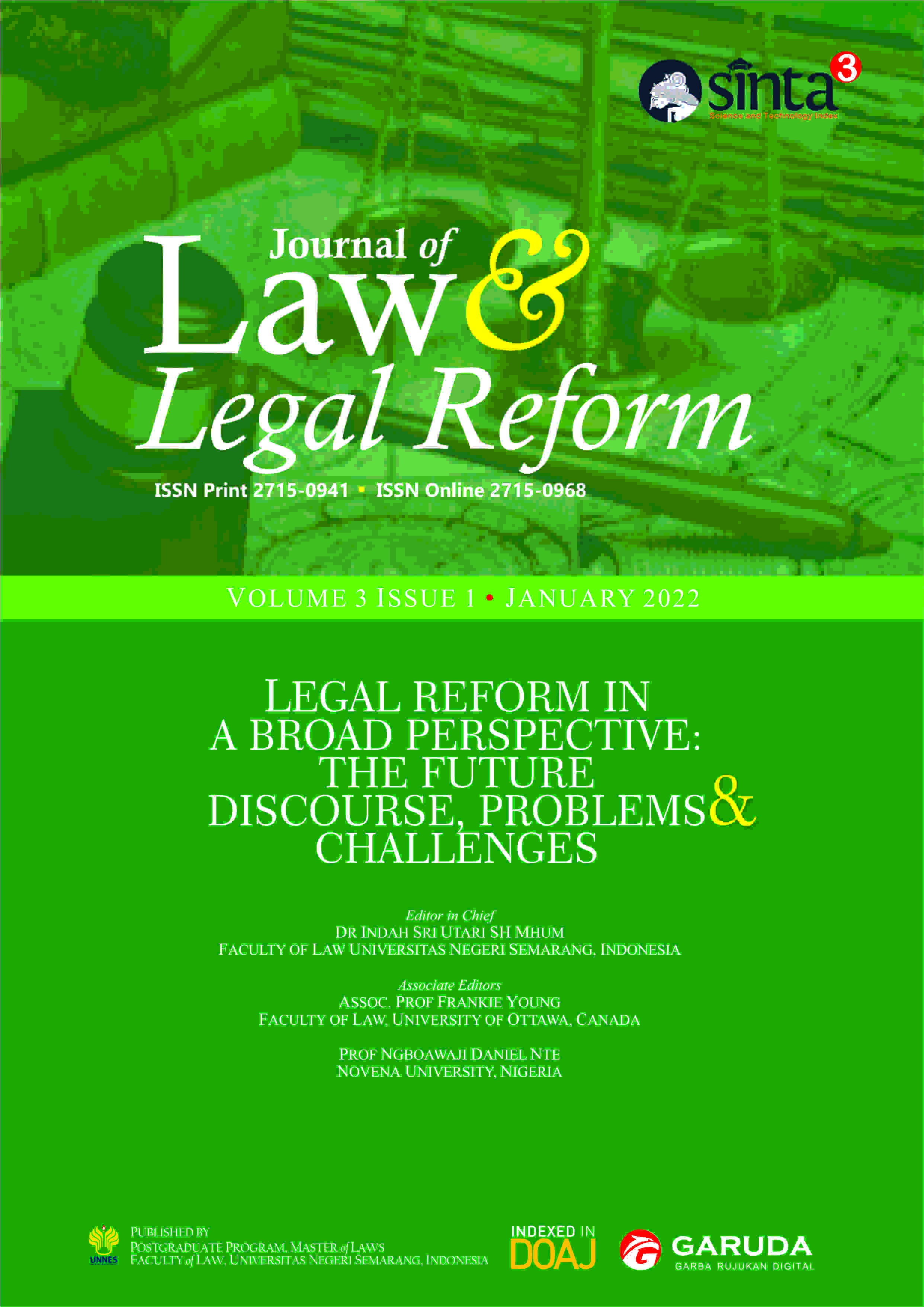Constitution Formulation and Amendment in Indonesian and American Legal System: A Comparative Study
Main Article Content
Abstract
The purpose of this study is to find out the comparison of constitutional law in Indonesia and the United States in terms of the development of the constitution and the mechanism for changing the constitution (UUD). The method used in this research is in the form of legal research. The type of research used for this approach is normative legal research. As in the United States constitution, Article V regulates how to amend the constitution. Meanwhile, in Indonesia, the mechanism for this change is regulated in Article 37 of the 1945 Constitution (UUD). The United States and Indonesia are countries that have adopted a presidential system of government with a republican form of government. In addition, the state institution authorized to make changes to the constitution of each country is the legislature. If in the United States the one who can amend the Constitution is the Congress consisting of the House of Representatives and the Senate, then in Indonesia the authority to make changes to the Constitution is the MPR, which includes the DPR and DPD. Then, the form of the constitution used by the two countries is the same as the Written Constitution. The existence of the United States Constitution is actually an effort to realize the principles stated in a Declaration of Independence (1776). The Declaration is based on French philosophical and English Enlightenment schools. The main purpose of the United States constitution is to guarantee the rights of the states.
Article Details

This work is licensed under a Creative Commons Attribution-NonCommercial-ShareAlike 4.0 International License.
All writings published in this journal are personal views of the authors and do not represent the views of this journal and the author's affiliated institutions. Author(s) retain copyrights under a Creative Commons Attribution-NonCommercial-ShareAlike 4.0 International (CC BY-NC-SA 4.0).
References
Adnan Buyung Nasution, (1995). Aspirasi Constitutional Government inIndonesia.Jakarta: Graffiti.
Agus Santoso M. Study on the Benefits of Legal Research for Regional Development, Legal Scientific Journal “Yuriska”, Vol. 3 No. 01 FH UWGM Samarinda, August 2011.
Aldri Frinaldi and Nurman S. Constitutional Changes and Implications for Changes in State Institutions. Journal of Democracy Vol. IV No.1 Th. 2005.
Anonim. (2006). Pokok the Basic Law of the State of . Jakarta: Achievement of the Publisher Library.
Astim Riyanto. Knowledge of Constitutional Law Becomes Knowledge of Constitutional Law. 44th Year Journal of Law and Development No. 2 April-June 2015.
Bintan Regen Saragih, (2006). Amendments to the Replacement and Stipulation of the Constitution in Indonesia, Bandung: CV. Utomo.
Blum, John M.; William S. McFeely, Edmund S. Morgan, Arthur M. Schlesinger, Jr., Kenneth M. Stampp, and C. Vann Woodward. The National Experience: A History of the United States (6th ed.). Harcourt Brace Jovanovich. 1985.
CFStrong, Modern Political Constitutions an Introduction to the Comparative study of their History and Existing form, London: Sidgwick Jackson Limited, 1996.
Dahlan Thaib, (2008). Constitutional Law and Theory. Jakarta: Raja Grafindo Persada. Dasril Radjab. (2005). Indonesian Constitutional Law. Jakarta: Rineka Cipta.
Darji Darmodiharjo, (1991). Santiaji Pancasila. Surabaya: National Effort.
Farid Arista Marzuk. Comparison of the Mechanism of Amendment to the Constitution between Indonesia and the United States. JOM Faculty of Law Volume III Number 2, October 2016.
Haris Fadillah Wildan. Comparison of the Constitutional Impeachment of the President and Vice President between the Republic of Indonesia and the United States in Realizing Democracy. Surakarta: Eleven March University. 2010.
Hendra Nurtjahjo, (2005). State Science, Jakarta: Raja Grafindo Persada.
Jaka Prima. (2019). Comparison of Legislative Powers in Indonesia and the United States. Malang: Master of Law at the Islamic University of Malang.
Jamie Hamidi. (2009). Comparative Constitutional Law. Jakarta: Achievement of the Publisher Library.
Jimly Asshidiqie. The idea of people's sovereignty in the constitution and its implementation in Indonesia, Jakarta: Ichtiar Baru-Van Horve, 1994.
Kasful Anwar Us. Dimensions of State Relations, Politics and Education. Ta'dib, Vol. XV. No. 02. Edition, November 2010.
KC Wheare, Modern Constitution, London: Oxford University Press, 1975. Muh. Kusnardi and Bintan Saragih, (1985). State Science. Jakarta: Perintis Press.
M. Agus Santoso. The Development of the Constitution in Indonesia. Yustisia Vol.2 No.3 September - December 2013.
Megawati. Perbandingan Konstitusi Negara Indonesia Dengan Negara Amerika Serikat Berdasarkan Bentuk Negara dan Sistem Pemerintahan https://justitiaindonesia.com/perbandingan-konstitusi-negara-indonesia dengan-negara-amerika-serikat-berdasarkan-bentuk-negara-dan-sistem pemerintahan/#:~:text=Perbandingan%20perubahan%20konstitusi%20Ind onesia%20dengan,melakukan%20amandemen%20sebanyak%2027%20kal i. 2020. Diakses tanggal 26 April 2021 jam 10.51 Wib.
Muh Mahfud, MD. (2003). Demokrasi dan Konstitusi di Indonesia, Studi Tentang Interaksi politik dan Kehidupan Ketatanegaraan. Jakarta: Rineka Cipta.
Mukti Fajar. (2005). Type of Rule of Law. Malang: Bayumedia.
Parlin M. Mangunsang, (1992). Constitutional Conversion as a Means of Amending the Constitution, Bandung: Alumni.
Satya Arinanto, Constitutional Law and Democratization in Indonesia. Jakarta: Publishing House Faculty of Law University of Indonesia, 2000.
Sayuti Una, (2004). Shifting the Power of Regional Government According to the Indonesian Constitution (Study on the Distribution of Power Between DPRD and Regional Heads After the Re-enactment of the 1945 Constitution), Yogyakarta: UII Press.
Sirojul Munir. The Identity of the Meaning of the Constitution with the Constitution in the State Administration System, Journal of the Study of Law and Justice. IUS Vol II Number 5 August 2014
Soerjono Soekanto, (1986). Pengantar LegalResearch,Jakarta: University Indonesia.
Sri Sumantri M, (1993). The Constitutional Structure According to the 1945 Constitution in the Indonesian Constitution in Indonesian Political Life, Jakarta: Sinar Harapan.
Taufiqurrohman Syahuri, (2014). Hukum Konstitusi (Proses dan Prosedur Perubahan UUD di Indonesia 1945-2002 serta Perbandingannya dengan Konstitusi Negara Lain di Dunia, Bogor: Ghalia Indonesia.
Tutik Quarterly Point, (2011). Construction of Indonesian Constitutional Law Post Amendment to the 1945 Constitution, Jakarta: Kencana.
Widodo Ekatjhajana. (2015). Negara Hukum, Konstitusi, dan Demokrasi: Dinamika dalam Penyelenggaraan Sistem Ketatanegaraan Republik Indonesia. Jember: Jember University Press.
William G. Andrews, Constitutionalism and Constitutionalism, edisi 3, New Jersey: Van Nestrand Company, 1968.
Wirjono Prodjodikoro, (1989). Asas-Asas Hukum Tata Negara di Indonesia, Jakarta: Dian Rakyat.
